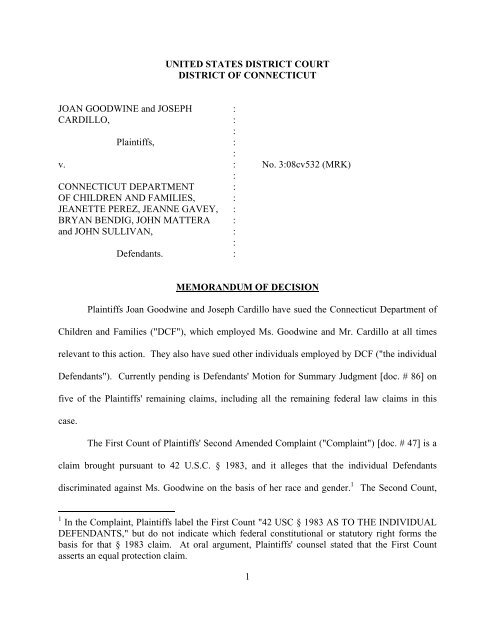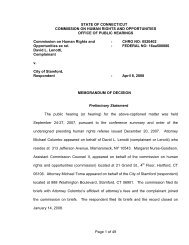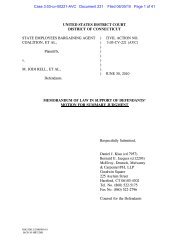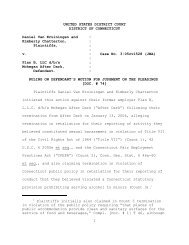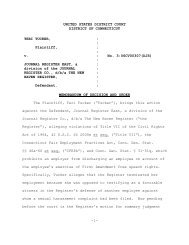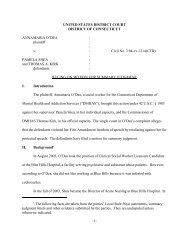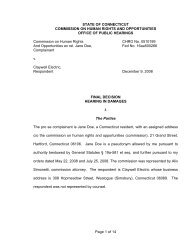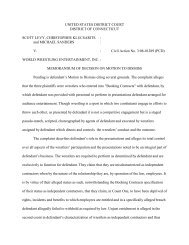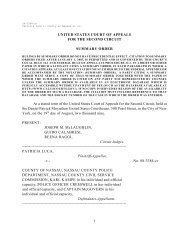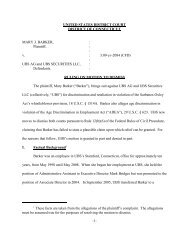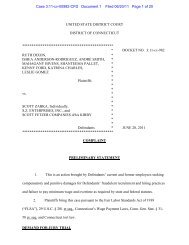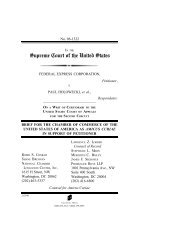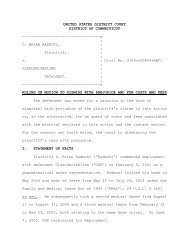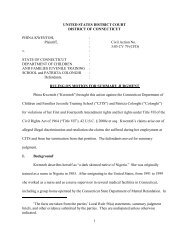Connecticut District Court decision, Goodwine v. DCF
Connecticut District Court decision, Goodwine v. DCF
Connecticut District Court decision, Goodwine v. DCF
You also want an ePaper? Increase the reach of your titles
YUMPU automatically turns print PDFs into web optimized ePapers that Google loves.
Resources on December 28, Ms. <strong>Goodwine</strong> reported that in the summer and fall of 2006, Mr.Bendig had more than once called her "goodswine" while passing her in the hallway, and that onone day during the same period, Mr. Bendig had made two comments about another employeebeing able to "kick [Ms. <strong>Goodwine</strong>'s] ass." On December 28, as a result of Ms. <strong>Goodwine</strong>'sreport, Mr. Bendig was placed on paid administrative leave.On January 4, 2007, Ms. Gavey met with Bryan Bendig and his union representative.Ms. Gavey then conferred with her superiors, Ms. Perez and Wanda Estrella, as well as the CadySchool management, Mr. Mattera, and Mr. Sullivan regarding the facts she had gathered and theappropriate level of discipline to impose. Human Resources recommended a five-daysuspension without pay, and the school management concurred. On January 16, 2007, <strong>DCF</strong> helda hearing pursuant to Cleveland Board of Education v. Loudermill, 470 U.S. 532 (1985), toassess the allegations against Mr. Bendig, and ultimately suspended Mr. Bendig for five dayswithout pay, as recommended by Human Resources. 2Mr. Bendig returned from his five-daysuspension on February 1, 2007. After Mr. Bendig returned from his five-day suspension, Ms.<strong>Goodwine</strong> and Mr. Bendig were never again assigned to the same classroom, and theirinteractions were limited to passing each other in the hallway and occasions when Mr. Bendigphoned the library and Ms. <strong>Goodwine</strong> answered.On January 22, 2007, Mr. Cardillo returned from a worker's compensation leave. In hiscapacity as union steward, Mr. Cardillo began inquiring with Mr. Mattera and Ms. Gaveyregarding the incident between Ms. <strong>Goodwine</strong> and Mr. Bendig. On or around January 30, 2007,Mr. Cardillo filed several grievances with <strong>DCF</strong> on behalf of Ms. <strong>Goodwine</strong>. None of those2An Office of Labor Relations ("OLR") arbitrator later overturned that discipline, and reinstatedMr. Bendig's five days of pay.4
grievances mentioned discrimination on the basis of race or sex. Rather, they alleged that Ms.<strong>Goodwine</strong> had been a victim of workplace violence, that <strong>DCF</strong> had failed to comply with agencystandards and the agency's workplace violence policy in its response to Ms. <strong>Goodwine</strong>'scomplaint, and that <strong>DCF</strong> was also in violation of state anti-bullying legislation. See Ex. 10 toMot. for Summary J. [doc. # 86-13]. 3 On February 16, 2007, Ms. <strong>Goodwine</strong> filed an AffirmativeAction Complaint with <strong>DCF</strong>'s Division of Diversity and Equity. See Affirmative Action Compl.,Ex. 12 to Mot. for Summary Judgment [doc. # 86-15]; Pls.' Local R. 56(a)(2) Statement [doc.# 99-3] at 65. 4After Mr. Cardillo returned to work in January 2007, he was assigned to a unit inBuilding 6 at the school. The parties dispute the reason for Mr. Cardillo's assignment toBuilding 6, as well as the timing of that assignment. Defendants claim that Mr. Cardillo wasassigned to Building 6 "[t]he first week [he] returned . . . because there was a need there for anInstructional Assistant [there]." See Defs.' Local R. 56(a)1 Statement [doc. # 86-2] 49.Plaintiffs claim that Building 6 was "a unit for especially hard to control children," and that Mr.Cardillo "was not initially assigned" to Building 6 on his return, but only "after he began tovigorously press the claims of Ms. <strong>Goodwine</strong>." See Pls.' Local R. 56(a)2 Statement [doc. # 99-3] 49. However, Plaintiffs do not state where Mr. Cardillo was "initially assigned." In any case,3Those grievances were all denied by <strong>DCF</strong> in March 2007. Ms. <strong>Goodwine</strong> then took one of thegrievances to the next level, the OLR, where it was denied in July 2007.4 The Affirmative Action Complaint alleged discrimination relating to race, color, sex, and age,as well as retaliation. See Affirmative Action Compl., Ex. 12 to Mot. for Summary J. [doc. # 86-15] at 1. More specifically, the complaint alleged that Ms. <strong>Goodwine</strong> was "struck by a whitemale for no reason whatsoever," that her "white supervisors . . . took 3 days to report [theincident] to Human Resources," that those supervisors "at no time were . . . concerned about[her] safety," and that "[the] agency [had] made a mockery of the violence in the workplacestandard." See id. at 2. On June 15, 2007, the Diversity Office wrote to Ms. <strong>Goodwine</strong> andadvised her that it had not found reason to believe that discrimination had occurred.5
on February 7, 2007, Mr. Cardillo, while working in Unit 6D within Building 6, responded to anemergency call from Unit 6C. In trying to break up a fight in Unit 6C, he sustained a headinjury, which left him permanently disabled.Ms. <strong>Goodwine</strong> and Mr. Cardillo filed their original Complaint [doc. # 1] on April 8,2008. On September 16, 2008, Plaintiffs filed their first Amended Complaint [doc. # 35], and onOctober 28, 2008, Defendants filed a Motion to Dismiss [doc. # 39] the Amended Complaint inpart. On December 10, 2008, the <strong>Court</strong> issued an Order [doc. # 44] directing the Plaintiffs to filea Second Amended Complaint that (1) removed Plaintiffs' § 1983 claim against <strong>DCF</strong> (CountTwo) and intentional infliction of physical injury claim against <strong>DCF</strong> (Count Eight) and (2)labeled the existing Counts One and Five as against the individual Defendants in their individualcapacities only. Plaintiffs' Second Amended Complaint [doc. # 47] – the operative complaint –was filed on December 14, 2008.On December 15, 2008, in light of the Second AmendedComplaint, the <strong>Court</strong> denied Defendants' Motion to Dismiss [doc. # 39] as moot. See Order[doc. # 48]. On January 28, 2010, Plaintiff Joan <strong>Goodwine</strong> filed a Motion for Partial SummaryJudgment [doc. # 63] as to Mr. Bendig only. In a Ruling and Order [doc. # 83] of June 1, 2010,the <strong>Court</strong> denied that motion. Defendants filed the pending Motion for Summary Judgment [doc.# 86] on June 30, 2010.II.The standard of review this <strong>Court</strong> must apply when reviewing a motion for summaryjudgment pursuant to Rule 56 is a familiar one. Summary judgment is appropriate only when"the movant shows that there is no genuine dispute as to any material fact and the movant is6
entitled to judgment as a matter of law." Fed. R. Civ. P. 56(a). 5"A dispute regarding a materialfact is genuine if the evidence is such that a reasonable jury could return a verdict for thenonmoving party." Williams v. Utica Coll. of Syracuse Univ., 453 F.3d 112, 116 (2d Cir. 2006)(quotation marks omitted). "The substantive law governing the case will identify those facts thatare material, and '[o]nly disputes over facts that might affect the outcome of the suit under thegoverning law will properly preclude the entry of summary judgment.'" Bouboulis v. Transp.Workers Union of Am., 442 F.3d 55, 59 (2d Cir. 2006) (quoting Anderson v. Liberty Lobby, Inc.,477 U.S. 242, 248 (1986)).The moving party bears the burden of demonstrating that no genuine issue exists as toany material fact, see Celotex Corp. v. Catrett, 477 U.S. 317, 323-25 (1986), and the <strong>Court</strong> mustresolve all ambiguities and draw all inferences in favor of the nonmoving party. See Anderson,477 U.S. at 255; Holcomb v. Iona Coll., 521 F.3d 130, 137 (2d Cir. 2008). If the moving partycarries its burden, the party opposing summary judgment may not rely on mere allegations ordenials, but rather must "cit[e] to particular parts of materials in the record" to demonstrate that afact is genuinely disputed. Fed. R. Civ. P. 56(c)(1). "An affidavit or declaration used to[demonstrate that a fact is genuinely disputed] must be made on personal knowledge, set outfacts that would be admissible in evidence, and show that the affiant or declarant is competent totestify on the matters stated." Fed. R. Civ. P. 56(c)(4). In short, the nonmoving party "must domore than simply show that there is some metaphysical doubt as to the material facts."Matsushita Elec. Indus. Co. v. Zenith Radio Corp., 475 U.S. 574, 586 (1986). "If the evidence ismerely colorable, or is not significantly probative, summary judgment may be granted."5 The wording and structure of Rule 56 of the Federal Rules of Civil Procedure changed as ofDecember 1, 2010, but there was no change in the substantive standard for summary judgment.7
Anderson, 477 U.S. at 249-50 (citations omitted).III.The <strong>Court</strong> first addresses Ms. <strong>Goodwine</strong>'s Title VII disparate treatment claim, Title VIIhostile work environment claim, and § 1983 equal protection claim.A.Title VII race- and sex-discrimination claims based on disparate treatment are governedby the familiar burden-shifting framework set forth in McDonnell Douglas Corp. v. Green, 411U.S. 792 (1973). A plaintiff may establish a prima facie case of discrimination by showing that:"1) she is a member of a protected class; 2) she was qualified for her position; 3) she suffered anadverse employment action; and 4) the action occurred under circumstances giving rise to aninference of discrimination." Norville v. Staten Island Univ. Hosp., 196 F.3d 89, 95 (2d Cir.1999). For the fourth element of the prima facie case, "[a] plaintiff relying on disparatetreatment evidence must show she was similarly situated in all material respects to theindividuals with whom she seeks to compare herself." Mandell v. County of Suffolk, 316 F.3d368, 379 (2d Cir. 2003). Although the question of whether two individuals are similarly situatedmay present a factual issue for a jury, "a court can properly grant summary judgment where it isclear that no reasonable jury could find the similarly situated prong met." Cine SK8, Inc. v.Town of Henrietta, 507 F.3d 778, 791 (2d Cir. 2007) (citation omitted).Once the plaintiff makes out a prima facie case, the burden shifts to the defendant toarticulate a legitimate, non-discriminatory rationale for the adverse action. See Norville, 196 F.3dat 95. "The burden is satisfied if the [defendant] articulates a 'clear and specific' reason which, if'taken as true, would permit the conclusion that there was a nondiscriminatory reason for theadverse action.'" Gladwin v. Pozzi, No. 10-748-cv, 2010 WL 5141233, at *3 (2d Cir. Dec. 20,8
2010) (quoting Schnabel v. Abramson, 232 F.3d 83, 88 (2d Cir. 2000)). If the defendant does so,"the burden shifts back to [the] plaintiff who must prove that a discriminatory reason was theactual reason for the employment action." Id. "Although intermediate evidentiary burdens shiftback and forth under this framework, the ultimate burden of persuading the trier of fact that thedefendant intentionally discriminated against the plaintiff remains at all times with the plaintiff."Id. (quoting Reeves v. Sanderson Plumbing Products, Inc., 530 U.S. 133, 143 (2000)).In this case, there is no dispute that Ms. <strong>Goodwine</strong> is a member of a protected class andthat she was qualified for her position. However, Defendants argue that Ms. <strong>Goodwine</strong> has notsuffered any adverse employment action, and that none of the actions alleged by Ms. <strong>Goodwine</strong>occurred under circumstances giving rise to an inference of discrimination. On both points, the<strong>Court</strong> agrees with Defendants.Employment actions that the Second Circuit has "deemed sufficiently disadvantageous toconstitute an adverse employment action include a termination of employment, a demotionevidenced by a decrease in wage or salary, a less distinguished title, a material loss of benefits,significantly diminished material responsibilities, or other indices unique to the particularsituation." Beyer v. County of Nassau, 524 F.3d 160, 163 (2d Cir. 2008) (citation, quotationmarks, and alteration omitted). In some cases, "[a] denial of a transfer may also constitute anadverse employment action, but [the Second Circuit] require[s] a plaintiff to proffer objectiveindicia of material disadvantage." Id. In this case, Ms. <strong>Goodwine</strong> was not demoted, her jobresponsibilities were not changed, she was not denied a promotion, and she did not even requesta transfer to an "objectively and materially better" position. See id. at 164.The only "adverse employment action" alleged by Ms. <strong>Goodwine</strong> is <strong>DCF</strong>'s <strong>decision</strong> toallow Mr. Bendig to return to work at the Cady School, rather than transferring him to another9
school. See Mem. in Opp'n [doc. # 99-10] at 34. Specifically, Ms. <strong>Goodwine</strong> alleges thatbecause Mr. Bendig was merely "giv[en] . . . a five day suspension and welcom[ed] back towork," she "had [a safe workplace] taken away from her," and "[s]he was also forced to workdaily alongside the man who attacked her, and forced to wonder if he would do it again." Id.Ms. <strong>Goodwine</strong> acknowledges, though, that there were "no further incidents" between her and Mr.Bendig following Mr. Bendig's return to work in February 2007. Pls.' Local R. 56(a)(2)Statement [doc. # 99-3] 52. Indeed, at her deposition she testified that although Mr. Bendig didpass her in the hallway after he returned, he never again addressed her in any way that wasinappropriate, and he never said or did anything that made her feel intimidated or threatenedphysically. See <strong>Goodwine</strong> Dep. at 200:8-21.What bothered Ms. <strong>Goodwine</strong> was "just [Mr. Bendig's] presence being there." Id. at200:21. Taken in the light most favorable to Ms. <strong>Goodwine</strong>, Ms. <strong>Goodwine</strong>'s depositiontestimony merely supports her claim that Mr. Bendig's return was subjectively bothersome toMs. <strong>Goodwine</strong>. Because the <strong>decision</strong> to allow Mr. Bendig to continue working at the CadySchool did not objectively and materially change the conditions of Ms. <strong>Goodwine</strong>'s employment,it did not constitute an adverse employment action. See, e.g., Spina v. Our Lady of Mercy Med.Ctr., No. 97cv4661 (RCC), 2003 WL 22434243, at *4 (S.D.N.Y. Oct. 22, 2003) (finding that thedefendant's refusal to transfer the plaintiff to another shift was not "a sufficiently adverse change,as the new position did not involve any significant improvement in the terms, privileges, orconditions of plaintiff's employment" and "[t]he only reason the plaintiff sought a transfer was toavoid working with [her alleged harasser]"), aff'd 120 F. App'x. 408 (2d Cir. 2005) (summaryorder); O'Dell v. Trans World Entm't Corp., 153 F. Supp. 2d 378, 396 (S.D.N.Y. 2001) (findingthat the defendant's failure to offer the plaintiff a new job not reporting to her alleged harasser10
Ms. <strong>Goodwine</strong> does not claim that she was disciplined while other employees whoengaged in the same conduct went undisciplined, but rather that her complaint regarding Mr.Bendig's misconduct was not treated with the same seriousness with which <strong>DCF</strong> treatedcomplaints by white female employees. See Mem. in Opp'n [doc. # 99-10] at 22-23.Nonetheless, the <strong>Court</strong> believes that the factors the Second Circuit has identified as relevant toevaluating disparate treatment claims based on allegations that similar misconduct by otheremployees went unpunished can be adapted for the purpose of evaluating Ms. <strong>Goodwine</strong>'s lessconventional employment discrimination claim. In this case, the relevant questions are: (1)whether the cases Ms. <strong>Goodwine</strong> cites as comparators involved employees "subject to the samestandards governing performance evaluation and discipline" as Mr. Bendig; and (2) whether thecomplainants in those cases "engaged in conduct" similar to Ms. <strong>Goodwine</strong>'s, including,presumably, making complaints similar to Ms. <strong>Goodwine</strong>'s original complaint against Mr.Bendig. See Norville v. Staten Island University Hosp., 196 F.3d at 96.In Ms. <strong>Goodwine</strong>'s case, Mr. Bendig was a science teacher at the school where she wasan Instructional Assistant, and Ms. <strong>Goodwine</strong> initially complained (1) that Mr. Bendig had hither on the side of her forehead, (2) that as a result she had a headache, and (3) that shortly afterMr. Bendig hit her he said, "I'll kick your ass." Labor Relations Investigation Report of Jan. 9,2007, Ex. 4 to Mot. for Summary Judgment [doc. # 86-7] at 2; <strong>Goodwine</strong> Aff. [doc. # 99-2] 10;Gavey Aff. [doc. # 86-30] 16. She also complained that Mr. Bendig had on several occasionscalled her "goodswine," and had previously commented "it looks like Rhea [Tompkins] kickedyour ass" and that he "took a poll of staff and they say that Rhea could kick your ass." LaborRelations Investigation Report of Jan. 9, 2007, Ex. 4 to Mot. for Summary Judgment [doc. # 86-7] at 2; <strong>Goodwine</strong> Aff. [doc. # 99-2] 7, 10; Gavey Aff. [doc. # 86-30] 19. After Ms.12
<strong>Goodwine</strong> made her complaint, Mr. Bendig was put on administrative leave, and then, followingan investigation and Loudermill hearing, Mr. Bendig was suspended without pay for five days.By contrast, according to Ms. <strong>Goodwine</strong>, "after Mr. Mattera harassed a white woman,[KM], at CJTS in 2002, he was removed from the school to the Central Office, and . . . after heharassed a white woman, [JS], at Central Office he was transferred back to CJTS." 6Mem. inOpp'n [doc. # 99-10] at 11. Ms. <strong>Goodwine</strong> also claims that when "[PD], a white woman,complained she was afraid of [JM], a white male teacher," JM "was transferred . . . to another<strong>DCF</strong> facility." Id. at 22.The basis for Ms. <strong>Goodwine</strong>'s statements regarding PD and JM is Ms. <strong>Goodwine</strong>'s owngeneral second-hand knowledge of that incident and the conclusory assertions of Mr. Cardillo,her co-Plaintiff, in his affidavit. See <strong>Goodwine</strong> Dep. [doc. # 86-21] at 68:23-71:4; Cardillo Aff.[doc. # 99-1] 15. In his affidavit, Mr. Cardillo merely states that "[PD], a white woman,complained that she was afraid of [JM], a white male teacher" and "[JM] was transferred fromCJTS to another <strong>DCF</strong> facility." Cardillo Aff. [doc. # 99-1] 15. At her deposition, Ms.<strong>Goodwine</strong> stated several times that she was "not sure exactly what happened" to PD and that shedid not "know all the details of that incident." <strong>Goodwine</strong> Dep. [doc. # 86-21] at 68:25-69:2,69:8-10, 69:18-22, 70:3-4, 71:2-4. Beyond Ms. <strong>Goodwine</strong>'s testimony at her deposition that sheheard that "[a] complaint was made" having "to do with [PD] being harassed by [JM]" which ledto JM being "no longer . . . there," the record contains no evidence of the particulars of the PD-JM incident. See id. at 70:8-71:3.Ms. <strong>Goodwine</strong>'s claims regarding the results of harassment complaints against Mr.Mattera are based solely on the unsupported statements of Mr. Cardillo. See Mem. in Opp'n6The <strong>Court</strong> refers to the non-party alleged victims and harasser by their initials.13
[doc. # 99-10] at 22-24. In his affidavit, Mr. Cardillo does not detail the nature of Mr. Mattera'salleged harassment of KM or JS, and he does not explain the basis for his belief that the incidentsinvolving those women were similar to the incident involving Ms. <strong>Goodwine</strong> and Mr. Bendig.See Cardillo Aff. [doc. # 99-1] 15. Nor did Mr. Cardillo provide that information at hisdeposition. See Cardillo Dep. [doc. # 102] at 161:5-166:16, 232:12-233:11, 253:1-7, 259:19-25.The scant evidence in the record does not indicate that the incidents involving Mr.Mattera are appropriate comparators. The "stipulated agreement" that followed KM’s complaintwas the result of a "negotiated settlement" – not, for example, a disciplinary <strong>decision</strong> following aLoudermill hearing. See Mattera Dep. at 16:3-25; Cardillo Dep. [doc. # 102] at 162:2. Withregard to the incident involving JS, Mr. Mattera testified at his deposition that the complaint byJS was found to be unsubstantiated, that there was no Loudermill hearing in that case, and that"nothing became of the complaint except that [he] went back to [his] position." See MatteraDep. at 23:8-16. In addition, while at the time Ms. <strong>Goodwine</strong> made her complaint, Mr. Bendigwas a teacher at the Cady School, when KM complained about Mr. Mattera, Mr. Mattera was theprincipal of the school. And when JS filed her complaint against Mr. Mattera, Mr. Mattera wasworking at <strong>DCF</strong>'s Central Office as Principal of the "No Nexus" Unit. See Mattera Aff. [doc. #86-31] 6. None of those facts suggest that the <strong>Goodwine</strong>-Bendig case is at all comparable tothe cases involving Mr. Mattera. See, e.g., Larson v. Portage Twp. Sch. Corp., 293 F. App'x415, 419-20 (7th Cir. 2008) (summary order) (noting that the plaintiff "offered [virtually] noevidence . . . that teachers at [the school] [were] subject to the same standards as the principal"and concluding that the plaintiff teacher "was in no way similarly situated" to the principal). Therecord contains no further information about KM's and JS's complaints or about the PD-JMincident.14
Contrary to Plaintiffs' suggestion, see Mem. in Opp'n [doc. # 99-10] at 34, it is notDefendants' burden to distinguish Mr. Mattera's and JM's cases from Mr. Bendig's. See Graham,230 F.3d at 41-42. Rather, it is Ms. <strong>Goodwine</strong>'s burden to show that she was similarly situatedto PD, KM, and JS. See, e.g., Norville, 196 F.3d at 96 ("Because [the plaintiff] producedinsufficient evidence . . . to show that the [employer] treated similarly situated employees morefavorably, she failed to establish a prima facie case of race discrimination."). Ms. <strong>Goodwine</strong>cannot satisfy that burden with mere "conclusory statements" or "allegations unsupported byadmissible evidence." Shumway v. United Parcel Service, Inc., 118 F.3d 60, 65 (2d Cir. 1997).The <strong>Court</strong> notes that Ms. <strong>Goodwine</strong> had more than ample opportunity to pursuediscovery to support her assertion that similarly situated white employees were treated betterthan her, but she did not do so. Plaintiffs did not subpoena <strong>DCF</strong> disciplinary records or take thedepositions of any of the Human Resources personnel involved in Ms. <strong>Goodwine</strong>'s case, PD'scase, or the cases of the two women allegedly harassed by Mr. Mattera. The <strong>Court</strong> must evaluateMs. <strong>Goodwine</strong>'s Title VII discrimination claim on the record before it. Within that record, thereis no evidence from which a reasonable jury could conclude that Ms. <strong>Goodwine</strong>'s race (or sex forthat matter) motivated <strong>DCF</strong>'s <strong>decision</strong> to allow Mr. Bendig to continue to work at the CadySchool and CJTS.Ms. <strong>Goodwine</strong> has offered no evidence showing that she was similarly situated to PD,KM, or JS – she has not provided specific evidence regarding the alleged actions of the threeother women's alleged harassers, the circumstances in which the women made their complaintsand <strong>DCF</strong> evaluated those complaints, or the process by which the alleged harassers weredisciplined. See Norville, 196 F.3d at 96 (holding that the plaintiff had not shown that heremployer treated her less favorably than similarly situated white nurses after she became15
disabled because "[t]he . . . record contain[ed] no evidence regarding the specific degree towhich either of [the other] nurses was disabled, the type of work they did prior to becomingdisabled, or the ways in which they were limited in performing their jobs").Furthermore, although Ms. <strong>Goodwine</strong>'s Complaint alleges that <strong>DCF</strong> discriminated againsther on the basis of both her race and sex in violation of Title VII, Ms. <strong>Goodwine</strong> has presentedno evidence at all that <strong>DCF</strong> treated Ms. <strong>Goodwine</strong> differently from other employees on the basisof her sex. Indeed, at the evidentiary hearing, Plaintiffs' counsel allowed that race discriminationwas the main crux of Ms. <strong>Goodwine</strong>'s two discrimination claims. 7Because Ms. <strong>Goodwine</strong> hasnot presented evidence from which a reasonable jury could conclude that she was treateddifferently from similarly situated white employees or similarly situated male employees, shecannot prevail on her Title VII discrimination claim.Finally, even if Ms. <strong>Goodwine</strong> could meet her prima facie burden – which she cannot –her Title VII discrimination claim would fail because Defendants have provided a lawfulexplanation for their <strong>decision</strong> not to transfer Mr. Bendig: "Human Resources personnel . . .consulted a <strong>DCF</strong> database of employee misconduct and determined that a similar allegation ofunauthorized touching of a co-worker had resulted in a one-day suspension." Mem. in Supp.[doc. # 86-1] at 12. <strong>DCF</strong>'s explanation is supported by the affidavit of Ms. Perez, who affirmedthat she recalled an incident with facts similar to those Ms. <strong>Goodwine</strong> alleged in her initialcomplaint and, after checking <strong>DCF</strong> records, proposed a punishment modeled on the disciplinaryaction taken in that earlier case. See Perez Aff. [doc. # 86-27] 9.7It bears mentioning that none of the grievances Ms. <strong>Goodwine</strong> filed in late January 2007alleged race or sex discrimination, and even Ms. <strong>Goodwine</strong>'s Affirmative Action Complaint ofFebruary 16, 2007 included no specific allegation that she was treated differently from similarlysituated white employees or male employees.16
In response to Defendants' stated reason for suspending Mr. Bendig, Ms. <strong>Goodwine</strong>simply cites Mr. Cardillo's affirmations that "[i]n his experience as a Union Steward and UnionVice President, violence of one employee against another is cause for termination," that "[h]ewas involved as Union Steward and Union Vice President in cases where employees of <strong>DCF</strong>were fired for implying that force would be used," and that "[i]mproper touching of the oppositesex is cause for involuntary transfer." See Mem. in Opp'n [doc. # 99-10] at 24; Cardillo Aff.[doc. # 99-1] 15. Even if the <strong>Court</strong> credited Mr. Cardillo's conclusory assertions – and the<strong>Court</strong> does not do so – they do not controvert Ms. Perez's testimony regarding the process shefollowed to determine the appropriate discipline for Mr. Bendig. Because Ms. <strong>Goodwine</strong> hasprovided no evidence from which a reasonable jury could conclude that Defendants' lawfulexplanation for their <strong>decision</strong> is mere pretext, Ms. <strong>Goodwine</strong>'s Title VII discrimination claimdoes not survive summary judgment.B.To prevail on a Title VII hostile work environment claim, a plaintiff must show "conduct(1) that is 'objectively' severe or pervasive – that is, [conduct that] creates an environment that areasonable person would find hostile or abusive [the 'objective' requirement], (2) that the plaintiff'subjectively perceive[s] as hostile or abusive' [the 'subjective' requirement], and (3) that createssuch an environment because of plaintiff's sex (or other characteristic protected by Title VII) [the'prohibited causal factor' requirement]." Gregory v. Daly, 243 F.3d 687, 691-92 (2d Cir. 2001)(citations omitted). The Second Circuit has instructed district courts as follows:The matter of whether the conduct alleged was so "severe or pervasive" as tocreate "an objectively hostile or abusive work environment," is to be decidedbased on the totality of the circumstances, in light of such factors as the"frequency of the discriminatory conduct; its severity; whether it is physicallythreatening or humiliating, or a mere offensive utterance; and whether it17
unreasonably interferes with an employee's work performance."Patterson v. County of Oneida, 375 F.3d 206, 227 (2d Cir. 2004) (quoting Harris v. ForkliftSystems, Inc., 510 U.S. 17, 21 (1993)). A plaintiff can establish a hostile work environmentclaim by showing "either that a single incident was extraordinarily severe, or that a series ofincidents were sufficiently continuous and concerted to have altered the conditions of herworking environment." Cruz v. Coach Stores, Inc., 202 F.3d 560, 570 (2d Cir. 2000) (citationand quotation marks omitted). "When a co-employee . . . is alleged to have engaged in harassingactivity, the employer will generally not be liable unless the employer either provided noreasonable avenue for complaint or knew of the harassment and did nothing about it." Quinn v.Green Tree Credit Corp., 159 F.3d 759, 766 (2d Cir. 1998) (citation and quotation marksomitted).Insofar as Mr. Bendig's conduct toward Ms. <strong>Goodwine</strong> may have risen to the level ofharassment actionable under the "hostile work environment" provision of Title VII, that conductcannot form the basis for Ms. <strong>Goodwine</strong>'s Title VII hostile work environment claim because: (1)Mr. Bendig was merely a co-employee of Ms. <strong>Goodwine</strong>'s; (2) Ms. <strong>Goodwine</strong> had a reasonableavenue for complaint, which she exercised; and (3) her employer, <strong>DCF</strong>, took action to remedythe situation as soon as it became aware of the alleged harassment. See Quinn, 159 F.3d at 766.There is no evidence that <strong>DCF</strong> was aware of or should have been aware of the allegedlyharassing behavior by Mr. Bendig before Ms. <strong>Goodwine</strong>'s report on December 26. Moreover,there was a complaint procedure in place – which Ms. <strong>Goodwine</strong> utilized – and her employertook prompt action. Indeed, Ms. <strong>Goodwine</strong> herself states that she is not imputing the actions ofMr. Bendig to <strong>DCF</strong>. See Mem. in Opp'n [doc. # 99-10] at 31.Ms. <strong>Goodwine</strong>'s hostile work environment claim apparently is based solely on events that18
transpired after Mr. Bendig was disciplined in January 2007. Contrary to Ms. <strong>Goodwine</strong>'sunsupported allegations, there is no evidence that she was harassed in violation of Title VII'shostile work environment provision following Mr. Bendig's return to work in February 2007.First, Ms. <strong>Goodwine</strong> has not shown that she was subject to harassment that was"objectively severe or pervasive." See Patterson, 375 F.3d at 227. The Second Circuit hasemphasized that "the fact that the law requires harassment to be severe or pervasive before it canbe actionable does not mean that employers are free from liability in all but the most egregiousof cases." Dawson v. County of Westchester, 373 F.3d 265, 273 (2d Cir. 2004) (citationomitted). However, "bare declarations of being 'treated poorly on the job and harassed' . . .cannot support a hostile work environment claim." Gregory, 243 F.3d at 692 (citation omitted).In this case, Ms. <strong>Goodwine</strong> has affirmed that she told Ms. Gavey that she was "uncomfortableand fearful about Mr. Bendig returning to work with [her]," <strong>Goodwine</strong> Aff. [doc. # 99-2] 16;that she made complaints to Mr. Mattera about "having to see and pass Mr. Bendig on a dailybasis" but that Mr. Mattera "never did anything about it," id. 25; that "[c]ommunication with[her] dropped dramatically" and her "emails were not given responses," id. 29; and that she was"treated as a troublemaker." Id. Ms. <strong>Goodwine</strong> also argues that Ms. Gavey's role as the hearingofficer who reviewed the grievances Ms. <strong>Goodwine</strong> filed with Mr. Cardillo's assistance was a"gross violation of due process" and contributed to a hostile work environment because Ms.Gavey herself was involved in the processes that were the subject of the grievances. See Mem.in Opp'n [doc. # 99-10] at 30-31.The core of Ms. <strong>Goodwine</strong>'s hostile work environment claim is that <strong>DCF</strong> inadequatelyresponded to Ms. <strong>Goodwine</strong>'s initial complaint about Mr. Bendig's alleged assault and verbalthreats. See Mem. in Opp'n [doc. # 99-10] at 31-32. But <strong>DCF</strong>'s response could not itself have19
created a hostile work environment because it did not objectively alter the conditions underwhich Ms. <strong>Goodwine</strong> worked. See Alfano, 294 F.3d at 373-74. Indeed, the Second Circuitrecently held that an employer's failure to investigate an employee's complaint of discriminationdid not by itself "alter the terms and conditions of [her] employment," and therefore "could notitself have contributed to or constituted a hostile work environment." Fincher v. DepositoryTrust & Clearing Corp., 604 F.3d 712, 724 (2d Cir. 2010). As the court explained, theemployer's failure to investigate the employee's complaint merely "preserved the verycircumstances that were the subject of the complaint." Id. In support of its holding, the courtnoted that "in the analogous context of hostile work environment claims based on allegations ofsexual harassment, federal courts . . . appear to have uniformly rejected the notion that a failureadequately to remediate sexual harassment itself constitutes an act that may contribute to ahostile work environment claim." Id. (citation, quotation marks, and alteration omitted).In Ms. <strong>Goodwine</strong>'s case, <strong>DCF</strong> did investigate Ms. <strong>Goodwine</strong>'s complaint, <strong>DCF</strong> put Mr.Bendig on administrative leave once it learned of the incident, and <strong>DCF</strong> disciplined Mr. Bendig.Moreover, as Ms. <strong>Goodwine</strong> herself admits, following his suspension, Mr. Bendig never againtouched her or made an offensive comment toward her. If anything, <strong>DCF</strong>'s response to Ms.<strong>Goodwine</strong>'s complaint improved "the . . . circumstances that were the subject the complaint."See id. Therefore, <strong>DCF</strong>'s <strong>decision</strong> to suspend rather than transfer Mr. Bendig did not create "anobjectively hostile or abusive work environment." See Patterson, 375 F.3d at 227.Ms. <strong>Goodwine</strong>'s argument that Ms. Gavey's role as the hearing officer who reviewed herworkplace violence grievances contributed to a hostile work environment is also without merit.Indeed, Ms. <strong>Goodwine</strong> cites no evidence in support of her claim that "Ms. Gavey undertook [thatrole] to ensure that the <strong>decision</strong> that she, Mr. Mattera and Dr. Sullivan reached and approved,20
was not overturned." See Mem. in Opp'n [doc. # 33-38] at 33. Nor does she cite any case law insupport of her claim that Ms. Gavey's actions constituted a "gross violation of due process." Seeid. In any case, as noted already, the one grievance that Ms. <strong>Goodwine</strong> took to the next level ofreview was denied by the Office of Labor Relations in July 2007. There is no evidence that Ms.<strong>Goodwine</strong> was in any way prejudiced by Ms. Gavey's review of her grievances, let alone thatMs. Gavey's involvement in the grievance review contributed to a "workplace . . . permeatedwith discriminatory intimidation, ridicule, and insult . . . sufficiently severe or pervasive to alterthe conditions of [Ms. <strong>Goodwine</strong>'s] employment and create an abusive working environment."Harris, 510 U.S. at 21.The other experiences that Ms. <strong>Goodwine</strong> complains of – not receiving responses toemails and having to share the hallways with an unsavory colleague – are the sort of "ordinarytribulations of the workplace" that the Title VII hostile work environment standards are meant to"filter out." Faragher v. City of Boca Raton, 524 U.S. 775, 788 (1998) (citation omitted) (notingthat those "standards . . . . are sufficiently demanding to ensure that Title VII does not become a'general civility code'" (citation omitted)). Ms. <strong>Goodwine</strong> has not alleged that she was subjectedto "offensive utterance[s]" after Mr. Bendig returned in February 2007, let alone any "physicallythreatening or humiliating" actions. See Harris, 510 U.S. at 23. Finally, Ms. <strong>Goodwine</strong>'sassertion that she was "treated as a troublemaker," <strong>Goodwine</strong> Aff. [doc. # 99-2] 29, is at best a"bare declaration[] of being treated poorly on the job," Gregory, 243 F.3d at 692 (citation andquotation marks omitted), and, as such, insufficient to support her hostile work environmentclaim. See id. Whether or not Ms. <strong>Goodwine</strong> subjectively perceived her environment to be"abusive" or "hostile" beginning in January or early February 2007, she has not proffered anyevidence that she was the victim of either "a single incident [that] was extraordinarily severe," or21
"a series of incidents [that] were 'sufficiently continuous and concerted' to have altered theconditions of her working environment" during that time period. Alfano v. Costello, 294 F.3d365, 374 (2d Cir. 2002) (citation omitted). Therefore, Ms. <strong>Goodwine</strong> has produced no evidenceof any post-December 2006 events that would satisfy the "objective" requirement of the Title VIIhostile work environment standard. Id.; see Gregory, 243 F.3d at 691.Second, as discussed already, there is no evidence that Ms. <strong>Goodwine</strong>'s race or sex was afactor in <strong>DCF</strong>'s <strong>decision</strong> to allow Mr. Bendig to return to work. There is also no evidence thatany of the alleged actions by <strong>DCF</strong> personnel following Mr. Bendig's return were motivated byMs. <strong>Goodwine</strong>'s race or sex. Indeed, in her brief in opposition to the Motion for SummaryJudgment, Ms. <strong>Goodwine</strong> cites Mr. Cardillo's affidavit for the proposition that "[w]hite womenhave been protected from their attackers" in a way that Ms. <strong>Goodwine</strong> was not, Mem. in Opp'n[doc. # 99-10] at 30, but she offers no further support for her claim that <strong>DCF</strong>'s actions wereracially and sexually motivated. Ms. <strong>Goodwine</strong> does suggest that "[Mr.] Bendig's repeated useof the word 'goodswine' [before January 2007] . . . is enough to show that he – for his part – hadracial animus." Id. at 26. However, as already noted – and as Ms. <strong>Goodwine</strong> does not dispute –Mr. Bendig's actions cannot be imputed to <strong>DCF</strong> because they occurred well before she made hercomplaint against Mr. Bendig on December 26, 2006. See id. at 31. According to Ms.<strong>Goodwine</strong>, prior to December 26, 2006, she never reported any of Mr. Bendig's inappropriateremarks to her supervisors. See Pls.' Local R. 56(a)(2) Statement [doc. # 99-3] 14, 15;<strong>Goodwine</strong> Dep. at 80:14-21, 100:2-22. Ms. <strong>Goodwine</strong> therefore fails to establish the prohibitedcausal factor requirement of her hostile work environment claim. See Vito v. Bausch & Lomb,Inc., No. 10-756-cv, 2010 WL 5129223, at *1 (2d Cir. Dec. 17, 2010) (summary order) ("[I]t isaxiomatic that in order to establish a . . . hostile work environment . . . a plaintiff must22
demonstrate that the conduct occurred because of her [membership in a protected class]."(citation omitted; alterations in original)).Because no reasonable jury could find on the basis of the evidence presented that Ms.<strong>Goodwine</strong> was subjected to a hostile work environment, her Title VII hostile work environmentclaim does not survive summary judgment. 8 C.In addition to the Title VII disparate treatment and hostile work environment claims, theComplaint includes a claim under 42 U.S.C. § 1983 that charges the individual Defendants with"discriminat[ing] against [Ms.] <strong>Goodwine</strong>, with intent, and out of racial and gender animosity"while "act[ing] under the color of law." Second Amended Compl. [doc. # 47] at 12, 48, 47. 9At the hearing on Defendants' summary judgment motion, Ms. <strong>Goodwine</strong>'s counsel informed the<strong>Court</strong> that this count is an equal protection claim.8 In the last paragraph of the "Facts" section of their Complaint, Plaintiffs state that "[s]ince thestart of 2007. . . both Plaintiffs have been subjected to a hostile work environment, based on raceand gender." Second Amended Compl. [doc. # 47] at 11, 43. However, the Third Count of theComplaint – the count that asserts a Title VII hostile work environment claim – alleges only thatDefendants subjected Ms. <strong>Goodwine</strong> to a hostile work environment; there is no mention of Mr.Cardillo. See id. 56-59. Furthermore, Plaintiffs' Memorandum in Opposition [doc. # 99-10]does not argue that Mr. Cardillo was subjected to a hostile work environment. Therefore, the<strong>Court</strong> does not construe the hostile work environment claim as having been asserted on behalf ofMr. Cardillo.9 Ms. <strong>Goodwine</strong> states that her § 1983 discrimination claim – the First Count of the Complaint –applies to "ALL INDIVIDUAL DEFENDANTS," and that "Defendant Mattera was thesupervisor of both Plaintiffs; Defendant Gavey was in charge of personnel matters for CJTS; andDefendant Sullivan was the Superintendant of the school district and Chief Enforcement Officerfor Sexual Harassment." Second Amended Compl. [doc. # 47] at 11. The First Count alsoalleges that "Defendants Mattera, Gavey, Perez, and Sullivan were charged with duties to protectpersons in the position of Plaintiff <strong>Goodwine</strong> from sexual harassment and from continuing postharassmentencounters with the sexual harasser and to protect persons in the position of PlaintiffCardillo from retaliation." Id. at 11-12. Although Mr. Bendig is one of the "individualdefendants" in this action, Mr. Bendig is not mentioned anywhere within the body of the FirstCount. As a consequence, the <strong>Court</strong> construes that claim not to be brought against Mr. Bendig.23
The Second Circuit has held that "[a] Title VII plaintiff is not precluded from bringing aconcurrent § 1983 cause of action, such as a claim for denial of equal protection, so long as the§ 1983 claim is based on a distinct violation of a constitutional right." Patterson, 375 F.3d at225 (citation and quotation marks omitted). "A § 1983 claim has two essential elements: (1) thedefendant acted under color of state law; and (2) as a result of the defendant's actions, theplaintiff suffered a denial of her federal statutory rights, or her constitutional rights orprivileges." Annis v. County of Westchester, 136 F.3d 239, 245 (2d Cir. 1998).Race-based or gender-based employment discrimination, whether it takes the form ofdisparate treatment or a hostile work environment, can form the basis of a § 1983 equalprotection claim. See Demoret v. Zegarelli, 451 F.3d 140, 149 (2d Cir. 2006). "Once actionunder color of state law is established, the analysis for such claims is similar to that used foremployment discrimination claims brought under Title VII, the difference being that a § 1983claim . . . can be brought against individuals." Id. Thus, to the extent Ms. <strong>Goodwine</strong>'s § 1983equal protection claim is based on allegations of disparate treatment, Ms. <strong>Goodwine</strong> has theburden of establishing that the action occurred under circumstances giving rise to an inference ofunlawful discrimination. See Das v. Consol. Sch. Dist. of New Britain, 369 F. App'x 186, 188(2d Cir. 2010) (summary order). To the extent that Ms. <strong>Goodwine</strong>'s § 1983 equal protectionclaim is based on allegations of a hostile work environment, she must produce evidence of a"workplace . . . permeated with discriminatory intimidation, ridicule, and insult, that issufficiently severe or pervasive to alter the conditions of the victim's employment and create anabusive working environment" – just as she must for her Title VII hostile work environmentclaim. Demoret, 451 F.3d at 149 (quoting Harris, 510 U.S. at 21). As in a Title VII hostile workenvironment claim, she also must demonstrate both "that she subjectively perceived the24
environment to be abusive" and "that the environment was objectively hostile and abusive." Id.As explained already, Ms. <strong>Goodwine</strong> has not produced evidence from which a reasonablejury could conclude either that she was the victim of an adverse employment action under TitleVII's disparate treatment provision, or that she was subject to workplace abuses severe orpervasive enough to constitute a hostile work environment under Title VII's hostile workenvironment provision. She also has not produced evidence from which a reasonable jury couldconclude that any individual Defendant, acting under color of state law, discriminated against heron the basis of her race or sex. Therefore, no reasonable jury could find for Ms. <strong>Goodwine</strong> onher § 1983 equal protection claim on the basis of the evidence Ms. <strong>Goodwine</strong> has presented, andthat claim does not survive summary judgment. 10IV.The <strong>Court</strong> next turns to Mr. Cardillo's claims – brought pursuant to Title VII and10Ms. <strong>Goodwine</strong> suggests several times in her brief in opposition to summary judgment that<strong>DCF</strong> violated Ms. <strong>Goodwine</strong>'s federal rights because it did not follow its own rules andprocedures in its response to Ms. <strong>Goodwine</strong>'s complaint against Mr. Bendig. See Mem. in Opp'n[doc. # 99-10] at 5, 24, 27, 31-33. However, the question of whether <strong>DCF</strong> followed its ownpolicies and "the Governor's Violence in the Workplace Policy," see id. at 31, is a matter of statelaw – it is only relevant to Ms. <strong>Goodwine</strong>'s Title VII and equal protection claims insofar as<strong>DCF</strong>'s alleged failure to follow the state regulations constituted an adverse employment action orcreated a hostile work environment. As discussed already, none of the alleged deficiencies in<strong>DCF</strong>'s response to Ms. <strong>Goodwine</strong>'s complaint rose to those levels. Ms. <strong>Goodwine</strong> has presentedno evidence that she was prejudiced by <strong>DCF</strong>'s alleged reporting failures. Indeed, although Ms.<strong>Goodwine</strong> argues that <strong>DCF</strong> violated state policies by not reporting the <strong>Goodwine</strong>-Bendigincident to the state police immediately, <strong>DCF</strong> did notify the state police of the incident shortlyafter Ms. <strong>Goodwine</strong> made her complaint. See Pls.' Local R. 56(a)(2) Statement [doc. # 99-3] 35; <strong>Goodwine</strong> Aff. [doc. # 99-2] 10-11. It was Ms. <strong>Goodwine</strong> who remained uncertain forseveral weeks whether she wanted to pursue a complaint with the state police. Moreover,according to Ms. <strong>Goodwine</strong>, after Ms. <strong>Goodwine</strong> eventually made a statement to the police, thepolice sought a warrant for Mr. Bendig's arrest, but a judge denied that request. See <strong>Goodwine</strong>Aff. [doc. # 99-2] 27. Finally, whether or not <strong>DCF</strong>'s alleged failure to follow its own rules andprocedures constituted an adverse employment action, that alleged failure would not violate Ms.<strong>Goodwine</strong>'s federal rights under Title VII and the Equal Protection Clause unless it entaileddiscrimination on the basis of Ms. <strong>Goodwine</strong>'s race or sex. There is no evidence that it did.25
42 U.S.C. § 1983 – that the Defendants retaliated against him because of his efforts "to protectthe rights" of Ms. <strong>Goodwine</strong>. Second Amended Compl. [doc. # 47] at 15.A.The standard for proving a claim of retaliation under Title VII, 42 U.S.C. § 2000e-3, issimilar to the standard for proving a claim of discrimination under Title VII. In order to establisha prima facie case of retaliation, a plaintiff must show: "(1) that [he] participated in an activityprotected by Title VII, (2) that [his] participation was known to [his] employer, (3) that [his]employer thereafter subjected [him] to a materially adverse employment action, and (4) that therewas a causal connection between the protected activity and the adverse employment action."Kaytor v. Elec. Boat Corp., 609 F.3d 537, 552 (2d Cir. 2010). If the plaintiff carries his primafacie burden, "the burden of production shifts to the defendant to proffer a legitimate nonretaliatoryreason for the adverse employment action." Id. at 552-53. Once the defendant doesso, the burden shifts back to the plaintiff to offer evidence "sufficient to permit an inference thatthe employer's proffered non-retaliatory reason is pretextual and that retaliation was a substantialreason for the adverse employment action." Id. at 553 (quotation marks and citation omitted).Mr. Cardillo alleges that Defendants retaliated against him when they assigned him toserve as an Instructional Assistant in Building 6 at the school, following his return from aworker's compensation leave. See Second Amended Compl. [doc. # 47] at 7, 14. Although Mr.Cardillo does not explain why his assignment to Building 6 constituted an adverse employmentaction, he does contend that it was an "assignment to the housing unit whose inmates who weretoo uncontrolled to attend regular classes with the others." Mem. in Opp'n [doc. # 99-10] at 36.The <strong>Court</strong> first considers whether Mr. Cardillo engaged in any activity that was protectedunder 42 U.S.C. § 2000e-3 before he was assigned to Building 6. Two different categories of26
activity are protected under § 2000e-3(a): "oppos[ing] any practice made an unlawfulemployment practice by" Title VII and "ma[king] a charge, testify[ing], assist[ing], orparticipat[ing] in any manner in an investigation, proceeding, or hearing under" Title VII.42 U.S.C. § 2000e-3(a). Although Mr. Cardillo and <strong>DCF</strong> disagree about the date of Mr.Cardillo's assignment to Building 6, Mr. Cardillo acknowledges that he was assigned to that unitno later than the first week in February 2007. See Cardillo Aff. [doc. # 99-1] 18. As Mr.Cardillo notes, in late January 2007, Mr. Cardillo filed several grievances on behalf of Ms.<strong>Goodwine</strong>. But those grievances, like Ms. <strong>Goodwine</strong>'s initial complaints to Human Resources,asserted only workplace violence complaints – they made no mention of sex-based or race-baseddisparate treatment or harassment. See Ex. 10 to Mot. for Summary Judgment [doc. # 86-13].There is no evidence that Mr. Cardillo made any complaints pursuant to Title VII or opposed anypractice made unlawful by Title VII in the month before he was assigned to Building 6. To theextent that Mr. Cardillo may have engaged in activity protected by Title VII later in February2007, those efforts cannot have caused his assignment to Building 6 several weeks earlier.Because Mr. Cardillo did not engage in activity protected by Title VII prior to the allegedadverse employment action, he fails to satisfy the prima facie burden for his Title VII retaliationclaim.Moreover, <strong>DCF</strong> has proffered a lawful explanation for the <strong>decision</strong> to assign Mr. Cardilloto Building 6: "he was assigned to a position in Unit 6D because there was a need for aninstructional assistant there." Defs.' Local R. 52(a)(1) Statement [doc. # 86-2] 49. Thatexplanation is supported by the affidavit of Ms. Mule, who has affirmed that she was responsiblefor assigning Mr. Cardillo and other Instructional Assistants to their respective students andclassrooms, see Mule Aff. [doc. # 86-28] 4, 30, and that Mr. Cardillo "was assigned to27
Building 6 . . . . because there was [a] gap in coverage for a student and [they] needed coverageby an Instructional Assistant." Id. 30. Mr. Cardillo has offered no evidence that <strong>DCF</strong>'sproffered explanation for his assignment is mere pretext; nor did he ever take Ms. Mule'sdeposition.Because Mr. Cardillo has not even established a prima facie case of retaliation inviolation of Title VII, because <strong>DCF</strong> has offered a lawful explanation for its <strong>decision</strong> to assignMr. Cardillo to Building 6, and because Mr. Cardillo has not shown any evidence of pretext, the<strong>Court</strong> need not reach the question of whether Mr. Cardillo's assignment constituted an adverseemployment action and whether "[a]s a direct and proximate result of [his assignment], [Mr.Cardillo] suffered and continues to suffer damages." Second Amended Compl. [doc. # 47] at 15, 68. However, although the <strong>Court</strong> does not reach the issue of whether Mr. Cardillo suffered anadverse employment action, it should be noted that Mr. Cardillo's representation of facts relevantto that element of his Title VII retaliation claim has been inconsistent. See Cardillo Dep. [doc.# 102] at 266:2-3, 266:10-21; Cardillo Aff. [doc. # 99-1] 18-19; Pls.' Local R. 52(a)(2)Statement [doc. # 99-3] 69-70; Mem. in Opp'n [doc. # 99-10] at 13.Regardless of whether Mr. Cardillo's assignment to a unit in Building 6 constituted anadverse employment action, for the reasons previously noted, no reasonable jury could find forMr. Cardillo on his Title VII retaliation claim on the basis of the evidence presented. Therefore,that claim does not survive summary judgment.B.The Fourth Count of the Second Amended Complaint asserts a claim of "42 USC § 1983Retaliation" against Mr. Mattera, Ms. Gavey, Ms. Perez, and Mr. Sullivan. Second AmendedCompl. [doc. # 47] at 14. A claim brought pursuant to 42 U.S.C. § 1983 must charge that the28
defendant, acting under color of state law, deprived the plaintiff of a federally protected right,such as a constitutional right. See Rendell-Baker v. Kohn, 457 U.S. 830, 838 (1982). However,"a § 1983 action may not . . . be brought to vindicate rights conferred only [by] a statute thatcontains its own structure for private enforcement, such as Title VII." Patterson, 375 F.3d at225. Thus, Mr. Cardillo's right under Title VII not to be retaliated against for engaging inactivity protected by Title VII cannot be the basis for his § 1983 retaliation claim. It is not clearfrom the operative complaint which federal statutory or constitutional right or privilege providesthe ground for Mr. Cardillo's § 1983 retaliation claim. When pressed at oral argument, Plaintiffs'counsel did not state which federal provision formed the basis for the § 1983 retaliation claimasserted in the Fourth Count of the Complaint – he only mentioned that the Equal ProtectionClause formed the basis for the § 1983 claim asserted in the First Count, which the <strong>Court</strong> hasalready addressed.Even assuming for the sake of argument that Mr. Cardillo's efforts on behalf of Ms.<strong>Goodwine</strong> in late January 2007 were protected activity under some federal statute orconstitutional provision, Mr. Cardillo's § 1983 retaliation claim still would fail. A § 1983plaintiff must show that the individually named defendants were personally involved in thealleged violation of his rights. See Farid v. Ellen, 593 F.3d 233, 249 (2d Cir. 2010). The SecondAmended Complaint alleges that four individual Defendants retaliated against Mr. Cardillo: Mr.Mattera, Ms. Gavey, Ms. Perez, and Mr. Sullivan. However, there is no evidence beyond Mr.Cardillo's unsupported suppositions that any of those Defendants were involved in the <strong>decision</strong>to assign Mr. Cardillo to Unit 6. Indeed, all of the evidence is to the contrary.First, Ms. Gavey has affirmed that she "had no involvement in Mr. Cardillo's assignmentsat CJTS" and "did not oversee or make determinations on staff assignments of CJTS employees."29
Gavey Aff. [doc. # 86-30] 41. Second, Ms. Perez has stated that "[a]s the Assistant HumanResources Administrator 3," she "supervise[d] [Ms.] Gavey and other Principal HumanResources Specialists." Perez Aff. [doc. # 86-27] 7. Ms. Perez also affirmed that she "hasspoken with [Mr.] Cardillo in passing while he has worked at Central Office during his periodsof light duty status while injured." Id. 6. Third, Mr. Sullivan has stated that he "played no rolein [Mr.] Cardillo's assignments within the Cady School." Sullivan Aff. [doc. # 25] 25. Fourth,Mr. Mattera has affirmed that he "do[es] not assign Instructional Assistants to their respectiveassignments [though] all changes in work hours did have to be approved by [him]" at the timeMr. Cardillo began work in Building 6. Mattera Aff. [doc. # 86-31] 39. Although Mr. Cardilloclaims that an email from Mr. Mattera proves that Mr. Mattera was responsible for assigning Mr.Cardillo to Building 6, in fact, that email is consistent with Mr. Mattera's Affidavit. See Email ofJan. 26, 2007 from John Mattera to Joseph Cardillo Re: "Assignment Hours," Ex. 8 to Mot. forSummary J. [doc. # 86-11] at 1 (stating that Mr. Cardillo "need[s] to know that all <strong>decision</strong>sregarding planning, scheduling or ANY programmatic issues or changes go through the principal[Mr. Mattera]," but making no mention of Mr. Cardillo's unit assignment in Building 6). 1111 In his brief in opposition to summary judgment, Mr. Cardillo argues briefly that a letter"threatening legal action" sent to Mr. Cardillo by Mr. Mattera's attorney on May 1, 2007 was"itself retaliation and evidence that the earlier [assignment to Building 6] was also retaliatory innature." Mem. in Opp'n [doc. # 99-10] at 36. The letter that Mr. Cardillo refers to demanded aretraction by Mr. Cardillo of statements by which Mr. Cardillo "attempted to impugn Mr.Mattera's personal and professional reputation and . . . sexual chastity," including somestatements made in "writings" filed with <strong>DCF</strong> between January and May 2007. Letter of May 1,2007 from Attorney Arthur D. Machado to Joseph Cardillo, Ex. D to Obj. to Mot. for SummaryJ. [doc. # 99-8] at 1. The letter was sent in accordance with <strong>Connecticut</strong> General Statutes § 52-237, which prevents a plaintiff from recovering general damages in a libel action "unless theplaintiff proves either malice in fact or that the defendant, after having been requested by theplaintiff in writing to retract the libelous charge . . . failed to do so." Id. To the extent that Mr.Cardillo suggests that Mr. Mattera sent him the letter in retaliation for activities Mr. Cardilloengaged in that were protected by Title VII, there is no indication that <strong>DCF</strong> – the only Defendant30
At his deposition, Mr. Cardillo could identify no specific basis for his belief that the otherthree named Defendants were involved in his assignment to Building 6. See Cardillo Dep. [doc.# 102] at 264:17. Although Mr. Cardillo asserted that the Mr. Mattera, Mr. Sullivan, Ms. Gavey,and Ms. Perez "had to have" "consulted each other" about sending him to Building 6, id. at264:19-20, he also admitted, "I can't prove it." Id. at 260:9-11.Indeed, as noted already, Barbara Mule has stated that she was responsible for assigningMr. Cardillo and other Instructional Assistants to their respective students and classrooms. SeeMule Aff. [doc. # 86-28] 4, 30. Mr. Cardillo has presented no evidence contradicting Ms.Mule's affidavit, even though his counsel could have taken Ms. Mule's deposition duringdiscovery. Thus, whatever its constitutional or statutory basis, Mr. Cardillo's § 1983 retaliationclaim does not survive summary judgment.C.The two retaliation counts in the Complaint allege only that Defendants retaliated againstMr. Cardillo. But in their briefs on summary judgment, both Plaintiffs and Defendants seem topresume that the Complaint alleges that Ms. <strong>Goodwine</strong>, too, was subject to retaliation.Assuming such a claim of retaliation against Ms. <strong>Goodwine</strong> were cognizable by the agreement ofthe parties – despite Ms. <strong>Goodwine</strong>'s failure to plead it in the Complaint – that claim fails aswell.First, under the standard applicable to Title VII retaliation claims, Ms. <strong>Goodwine</strong>suffered no adverse employment action. Although Title VII's anti-retaliation provision prohibitsnamed in Mr. Cardillo's Title VII retaliation claim – had any involvement with the letter. Sincethere is no evidence beyond Mr. Cardillo's unsupported suppositions that Mr. Mattera was theperson to assign Mr. Cardillo to Building 6 in late January or early February 2007, Mr. Mattera'spersonal demand for a retraction in May 2007 has no bearing on the reason for Mr. Cardillo'sBuilding 6 assignment. See Mem. in Opp'n [doc. # 99-10] at 36.31
a broader range of acts than Title VII's anti-discrimination provision, see Burlington Northern &Santa Fe Rwy. Co. v. White, 548 U.S. 53, 67 (2006), the anti-retaliation provision nonethelessprotects employees only from retaliation that results in "injury or harm" – specifically, from"materially adverse" acts "that . . . well might have dissuaded a reasonable worker from makingor supporting a charge of discrimination." Id. at 67-68. According to Ms. <strong>Goodwine</strong>, "[t]heevents [that she cites as] constituting hostile work environment . . . are also [] events constitutingretaliation." Mem. in Opp'n [doc. # 99-10] at 35. Those events include <strong>DCF</strong>'s failure to"remove[]" Mr. Bendig from the Cady School and CJTS, id. at 30; "allowing Ms. Gavey to ruleon complaints made against herself," id. at 30-31; and the alleged failure of some administratorsto answer "normal communications" from Ms. <strong>Goodwine</strong> "[s]ince the start of 2007." Id. at 30;<strong>Goodwine</strong> Aff. [doc. # 99-2] 29.As discussed already, <strong>DCF</strong>'s <strong>decision</strong> to suspend rather than transfer Mr. Bendig did notobjectively injure or harm Ms. <strong>Goodwine</strong>. If anything, the disciplinary action taken against Mr.Bendig benefited Ms. <strong>Goodwine</strong>, since following his suspension, Mr. Bendig never again did orsaid anything inappropriate to Ms. <strong>Goodwine</strong>. Moreover, even if there were objective groundsfor Ms. <strong>Goodwine</strong>'s dissatisfaction with <strong>DCF</strong>'s <strong>decision</strong> not to transfer Mr. Bendig, theinadequacy of <strong>DCF</strong>'s response would not transform that response into a retaliatory adverseemployment action. As another district court in this Circuit has noted, "[a]ffirmative efforts topunish a complaining employee are at the heart of any retaliation claim." Tomlinson v. SharpElectronics Corp., No. 99cv9539 (CM), 2000 WL 1909774, at * 4 (S.D.N.Y. Dec. 18, 2000).Thus, a plaintiff claiming that she suffered a retaliatory adverse employment action after shecomplained of sex- or race-discrimination cannot simply allege that her employer's response toher complaint was deficient. See, e.g., O'Dell, 153 F. Supp. 2d at 396 (noting that "an alleged32
deficiency in an employer's internal complaint procedure or internal investigation of a sexualharassment complaint – even if the deficiency is little more than an attempt to strengthen anemployer's defense – is not a retaliatory adverse employment action" (citing United States v. NewYork City Transit Auth., 97 F.3d 672, 677 (2d Cir. 1996))). Therefore, <strong>DCF</strong>'s failure to removeMr. Bendig from the Cady School and CJTS as a result of Ms. <strong>Goodwine</strong>'s complaint did notconstitute a retaliatory adverse employment action.Furthermore, there is no evidence whatsoever that Ms. Gavey's review of Ms.<strong>Goodwine</strong>'s grievances prejudiced Ms. <strong>Goodwine</strong> in any way. Ms. <strong>Goodwine</strong> herself suggeststhat Ms. Gavey's involvement in the review of her grievances was not exceptional, and wasconsistent with <strong>DCF</strong> practices. See Pls.' Local R. 56(a)(2) Statement [doc. # 99-3] 62. 12Theonly other specific harm alleged by Ms. <strong>Goodwine</strong> – not receiving responses to emails, see<strong>Goodwine</strong> Aff. [doc # 99-2] 29 – is one of the "minor annoyances that often take place atwork," and as such, it is not actionable under Title VII's anti-retaliation provision. BurlingtonNorthern, 548 U.S. at 68 (explaining that "normally petty slights, minor annoyances, and simplelack of good manners" will not "deter victims of discrimination from complaining to the EEOC,the courts, and their employers" (citation and quotation marks omitted)).Second, Ms. <strong>Goodwine</strong> has not argued – let alone offered any evidence – that theindividual Defendants took their allegedly retaliatory actions because Ms. <strong>Goodwine</strong> engaged in12Defendants stated that "Ms. Perez frequently receives complaints about HR investigations andcannot practically reassign hearing officers each time she receives an unsubstantiated complaintof bias or conflict of interest; she makes reassignments of hearing officers only when presentedwith facts that support a conclusion that a hearing officer may have an actual conflict of interest."Defs.' Local R. 56(a)(1) Statement [doc. # 86-2] 62. Plaintiffs replied: "DENIED as to lack ofduty to reassign officers. No employee of <strong>DCF</strong> should have the right to judge him or herself.This claim by Defendants establishes that <strong>DCF</strong> maintained a pattern and practice of allowingmanagers and supervisors to act in the event of conflicts of interest and to judge their own prioractions in relation to other employees . . . ." Pls.' Local R. 56(a)(2) Statement [doc. # 99-3] 62.33
activity protected by a federal statute or constitutional provision other than Title VII, such as theFirst Amendment. See, e.g., Ezekwo v. New York City Health & Hosps. Corp., 940 F.2d 775,781 (2d Cir. 1991) (observing that employee complaints that "[are] personal in nature andgenerally related to [the employee's] own situation" do not address "matters of public concern"and hence are not protected activity under the First Amendment). Therefore, there is no basis forMs. <strong>Goodwine</strong> to bring a retaliation claim under § 1983. In any case, Ms. <strong>Goodwine</strong>'s failure topresent evidence from which a reasonable jury could conclude that she suffered an adverseemployment action according to the standard for Title VII retaliation claims would also doom aretaliation claim brought pursuant to § 1983. See, e.g., Zelnik v. Fashion Inst. of Tech., 464 F.3d217, 227 (2d Cir. 2006) (noting that the Second Circuit's standard for finding an adverseemployment action in the First Amendment retaliation context "has always been the equivalentto the standard set forth [for Title VII retaliation claims] in Burlington Northern").Thus, to the extent that the Complaint can be construed to contain a claim thatDefendants unlawfully retaliated against Ms. <strong>Goodwine</strong>, that claim too would fail because thereis no evidence from which a reasonable jury could conclude that any of the Defendants retaliatedagainst Ms. <strong>Goodwine</strong> in violation of Title VII or § 1983.V.In addition to her federal claims, Ms. <strong>Goodwine</strong> charges Mr. Bendig with trespass againstthe person, a state common law tort. Supplemental or pendent jurisdiction is a matter ofdiscretion, not of right. See United Mine Workers v. Gibbs, 383 U.S. 715, 715-26 (1966). Acourt may decline to exercise supplemental jurisdiction when the court has dismissed all claimsover which it has original jurisdiction. See 28 U.S.C. § 1367(c)(3); see, e.g., Roncallo v.Sikorsky Aircraft Corp., No. 3:09cv126 (MRK), 2010 WL 4365764, at *11 (D. Conn. Oct. 22,34
2010). Because the <strong>Court</strong> grants Defendants' motion for summary judgment with regard to all ofPlaintiffs' federal claims, the <strong>Court</strong> declines to exercise supplemental jurisdiction over Ms.<strong>Goodwine</strong>'s remaining state law claim. Should she wish to do so, Ms. <strong>Goodwine</strong> is free to raiseher state law claim against Mr. Bendig in the <strong>Connecticut</strong> state courts.VI.For the foregoing reasons, Defendants' Motion for Summary Judgment [doc. # 86] isGRANTED. Ms. <strong>Goodwine</strong>'s state law claim against Mr. Bendig is DISMISSED withoutprejudice to renewal in state court. The Clerk is directed to enter judgment for Defendantson Plaintiffs' Title VII and § 1983 claims and to close this file.IT IS SO ORDERED./s/]Mark R. KravitzUnited States <strong>District</strong> JudgeDated at New Haven, <strong>Connecticut</strong>: January 14, 2011.35


